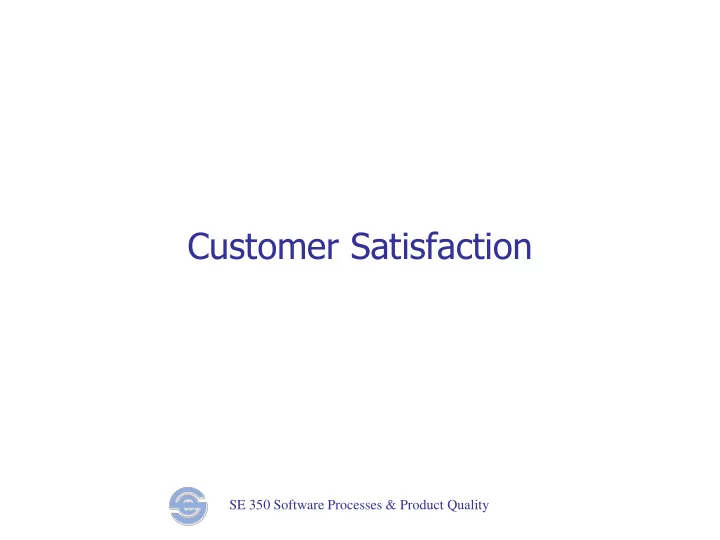

Customer Satisfaction SE 350 Software Processes & Product Quality
Overview Defining customer satisfaction objectives: Overall satisfaction % (total customer satisfaction?) Satisfaction vs. delight Objectives for individual aspects Practices: Expectation management Support & service Relationship management Measurement & Metrics: Customer satisfaction surveys Reasons for selecting product Metrics: satisfaction trends, customer complaints, market share, repurchase SE 350 Software Processes & Product Quality
Satisfaction Objectives % of satisfied customers: Target set relative to competition TQM approach is “Total Customer Satisfaction” Must satisfy every customer fully Consider whether to target customer delight Go beyond “absence of problems” How we define satisfaction depends on market characteristics & business objectives: “What makes business sense?” SE 350 Software Processes & Product Quality
Total Customer Satisfaction A TQM practice: no dissatisfied customer For example, “Satisfaction guaranteed or money back” Can have significant impact on corporate image, loyalty Requires willingness to address niche problems For example, “Your software is incompatible with X that I use” Requires empowerment of employees Impacts cost, processes (need more flexibility) Can be exploited by unreasonable customers SE 350 Software Processes & Product Quality
Why? From "Customer Satisfaction: How Good Is Good Enough?" by Pete Babich. Quality Progress, December 1992 SE 350 Software Processes & Product Quality
Customer Delight Satisfaction only addresses “absence of problems” “Met expectations” Can target customer delight Exceeding expectations: superior user interface, automatically fixing/correcting erroneous input or problems, … Requires pursuing opportunities for “going the extra mile” Significant impact on “willingness to recommend” & “willingness to repurchase”, loyalty, image Possibility of “gold - plating,” may increase costs SE 350 Software Processes & Product Quality
Factors Influencing Satisfaction Product quality in all quality attributes Level of expectations Support & service Initial customer experience with product Interactions related to product: Marketing, buying experience Interactions with development team (if any) Support experience SE 350 Software Processes & Product Quality
Practices SE 350 Software Processes & Product Quality
Expectation Management Satisfaction is relative to expectations: For example, Lord of the Rings Part 3 vs. an unknown movie Based on “value proposition” More expected from Mercedes than Hyundai Different expectations for Ferrari & Cadillac Expectation setting: Marketing, delivery and feature promises Requirements interactions Eliciting requirements that cannot be met can be a major problem Corporate image, past products General expectations for the product category Technical documentation, presentations Setting & meeting reasonable expectations leads to high satisfaction For example, Southwest airlines SE 350 Software Processes & Product Quality
Value Proposition “What it costs, what it provides” A product has a strong value proposition if: It is strong on those attributes that are important to the customer It provides better value for its particular group of customers than its competition – key to market share Often products are aimed at “market segments” Group of customers with a particular set of needs Particular combination of attributes that they value SE 350 Software Processes & Product Quality
Value Proposition – cont’d Product design and satisfaction measurement should address the attributes that the customers care about Designers and quality engineers must be conscious of the value proposition desires of their clientele: all quality attributes are NOT created equal! Articulating value proposition key to marketing “Good on all aspects” often carries lower credibility SE 350 Software Processes & Product Quality
Support & Service Helping people to get started using the system Startup training / tutorials / documentation Helping users to be more effective in using product Reference manuals, tips, training Providing support in resolving problems Tech support lines, troubleshooting guides, FAQs Helping customers help each other Customer groups, “sharing” facilities: space, mailing lists Systems for problem reporting & tracking Distributing patches & updates Release notes on differences from previous versions, known bugs SE 350 Software Processes & Product Quality
Problem Reporting & Tracking Tools for problem reporting & tracking. Examples: Rational ClearQuest, Seapine’s TestTrack Pro, Bugzilla Problem reports may be filled in directly by customers or by customer support people Each problem “dispositioned” Removal of duplicates / non-problems Fix later / fix now, assigned to developer Tracking of fixing status through to re-release Generates metrics on fixing cycletime, fixing effectiveness Can use same tools to track feature requests SE 350 Software Processes & Product Quality
Relationship Management Working with customers in ways that build loyalty “Studies show that it is five times more costly to recruit a new customer than it is to keep an old customer, and that dissatisfied customers tell 7 to 20 people about their experiences, while satisfied customers tell only 3- 5.” [Kan textbook, p. 375] The most effective advertising is word-of-mouth Addressing special needs, responsiveness to concerns of key customers For example, special patches, features, feature prioritization, deadlines Disclosure: proactive notification & resolution of known bugs Identifying and following up on issues & irritants Reducing “total cost of ownership,” such as with free upgrades More applicable to “major customers” than mass -market products SE 350 Software Processes & Product Quality
Summary Customer satisfaction is the ultimate measure of quality Move from Satisfaction to Delight Satisfaction depends on: Product Quality Support Expectation Management SE 350 Software Processes & Product Quality
Recommend
More recommend